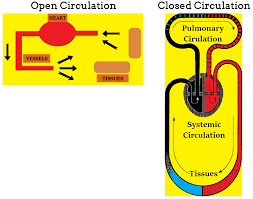How Open and Closed Circulatory Systems Affect Organism Function
A circulatory system is essential in most multicellular organisms for transporting nutrients, oxygen, and other substances throughout the body. There are two main types of circulatory systems: open and closed. Understanding the difference between open and closed circulatory system helps us see how organisms adapt to their environments and maintain life processes.
In an open circulatory system, the circulating fluid (often referred to as haemolymph) moves freely within body cavities, bathing organs directly. In a closed circulatory system, blood circulates strictly within a network of vessels, ensuring more efficient transport of substances.
What is an Open Circulatory System?
An open circulatory system is found in many invertebrates such as arthropods (cockroaches, spiders, crabs) and some molluscs (snails, clams). Here, the heart pumps haemolymph into open-ended vessels. This fluid leaves the vessels, enters body cavities or sinuses, and comes into direct contact with tissues.
Key Points:
Blood (haemolymph) directly bathes organs.
Blood and interstitial fluid are not distinct.
Common open circulatory system examples: Cockroaches, snails, spiders, crabs.
Generally lower blood pressure and slower flow.
No capillaries or a well-defined network of vessels.
What is a Closed Circulatory System?
A closed circulatory system is typically seen in vertebrates (fish, amphibians, reptiles, birds, mammals) and certain invertebrates like annelids (earthworms). In this system, blood remains confined within vessels—arteries, veins, and capillaries—throughout circulation.
Key Points:
Blood does not come into direct contact with tissues; exchange occurs through capillaries.
Blood and interstitial fluid are distinct.
Common closed circulatory system examples: Humans, cats, earthworms.
Higher blood pressure and faster flow.
Presence of well-developed vessels (arteries, veins, and capillaries).
Major Differences between Open and Closed Circulatory Systems

Additional Points and Unique Facts
Evolutionary Aspect: The closed circulatory system allows for higher metabolic rates and greater activity, which is why most large and highly active organisms possess it.
Energy Efficiency: Open systems require less energy to maintain but may not support very high metabolic demands. Closed systems, while more energy-intensive, provide precise delivery of nutrients and gases.
Quick Quiz (with Answers)
Which type of circulatory system involves haemolymph directly bathing the internal organs?
A) Closed circulatory system
B) Open circulatory system
Answer: B) Open circulatory system
Which one of these is a closed circulatory system example?
A) Cockroach
B) Human
Answer: B) Human
Where does gas exchange mainly occur in a closed circulatory system?
A) Sinuses
B) Capillaries
Answer: B) Capillaries
Which system typically has more control over blood volume and flow?
A) Open circulatory system
B) Closed circulatory system
Answer: B) Closed circulatory system
Simple Mnemonic for Key Differences
Try this mnemonic “OPEN: Organ Pool, ENcloses nothing” to remember that open circulatory systems let fluid pool around organs rather than enclosing blood in vessels.
And “CLOSE: Circulation Locked, Organised, Systemic & Efficient” for closed circulatory systems that are organised, locked in vessels, and more efficient.
Both open and closed circulatory systems play a vital role in transporting essential materials to support life processes. Open circulatory systems are found in smaller or less active organisms like cockroaches and snails, while closed circulatory systems typically occur in more complex or larger organisms such as humans and earthworms. The primary difference between open and closed circulatory system lies in how blood is circulated and how nutrients, gases, and wastes are exchanged with tissues.
Related Topics


FAQs on Open vs Closed Circulatory System: Detailed Comparison
1. Why do insects like cockroaches have an open circulatory system?
Insects generally have lower metabolic demands compared to large mammals and can efficiently use an open circulatory system. Their body structure and the presence of a tracheal system for gas exchange mean they do not rely on haemolymph to carry oxygen extensively.
2. How is blood flow regulated in a closed circulatory system?
In a closed circulatory system, blood flow is regulated by the contraction and relaxation of blood vessels as well as the pumping action of the heart. This allows an organism to increase or decrease blood supply to specific tissues.
3. Are there any invertebrates with a closed circulatory system?
Yes, annelids (e.g., earthworms) and some cephalopod molluscs (e.g., squids and octopuses) have closed circulatory systems.
4. What is the role of respiratory pigments in a closed circulatory system?
Respiratory pigments like haemoglobin bind oxygen (and sometimes carbon dioxide) and help transport these gases to and from tissues, increasing the efficiency of gas exchange.
5. Can organisms with an open circulatory system be large in size?
While most large and highly active creatures have closed circulatory systems, some large invertebrates (such as certain crustaceans) still have open systems. However, they often have adaptations to improve oxygen transport, like specialised areas with more extensive contact with haemolymph.










